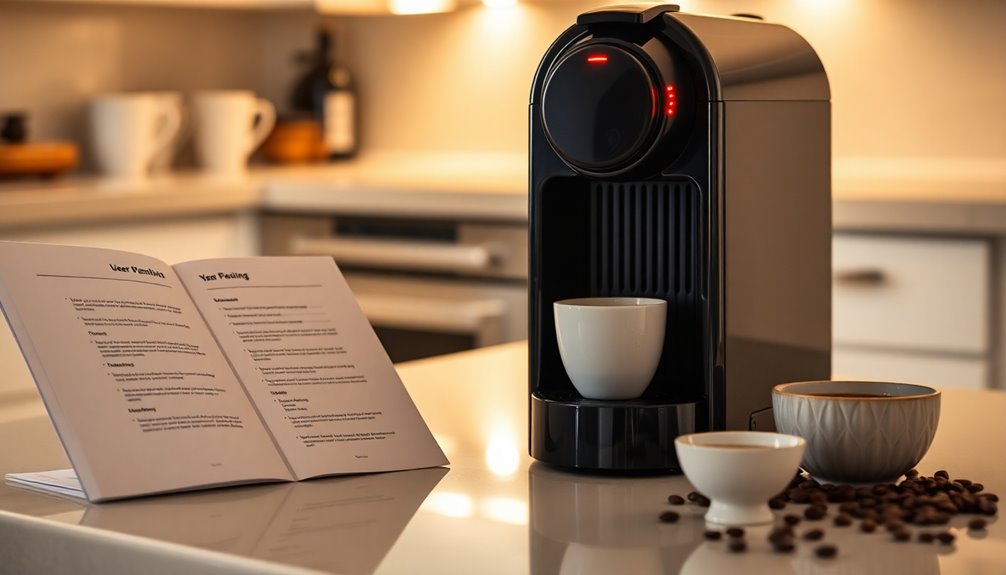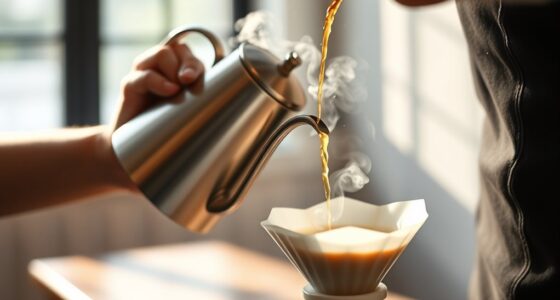The ideal temperature for your cappuccino should be between 60°C and 65°C (140°F to 149°F). This range guarantees that the milk is hot enough to create a creamy texture and stable foam without losing flavor. Milk heated above 70°C may develop a burnt taste and negatively affect sweetness. To achieve the best results, use a thermometer to monitor the temperature closely during frothing. By mastering the right heating techniques, you'll enhance the overall quality of your drink. If you're curious about more tips for making the perfect cappuccino, you'll find plenty of helpful information ahead.
Key Takeaways
- The ideal cappuccino temperature range is between 60°C to 65°C (140°F to 149°F) for optimal flavor and texture.
- Heating milk above 70°C can lead to bitterness and compromise the overall flavor of the cappuccino.
- Consistent temperature monitoring is crucial to achieve creamy texture and stable foam in cappuccinos.
- Using a contactless digital thermometer ensures accurate and hygienic temperature readings for milk.
- Proper frothing techniques should maintain milk temperature between 150°F to 155°F (65°C to 68°C) for the best microfoam stability.
Importance of Milk Temperature

When crafting the perfect cappuccino, milk temperature plays a vital role in determining the drink's overall quality. The ideal milk temperature hovers around 60°C (140°F), enhancing both the creamy texture and flavor profile.
If you overheat the milk, you'll end up with burnt milk that ruins your drink, while underheating leads to weak foam stability and texture. Maintaining that perfect milk temperature not only delivers rich, sweet notes but also guarantees your foam holds its shape.
Heating milk above 70°C can negatively affect your froth quality, leaving you with a thinner foam and a less enjoyable experience. Keeping a close eye on milk temperature is essential for achieving a uniform taste and quality in every cappuccino you serve.
Optimal Cappuccino Temperature Range
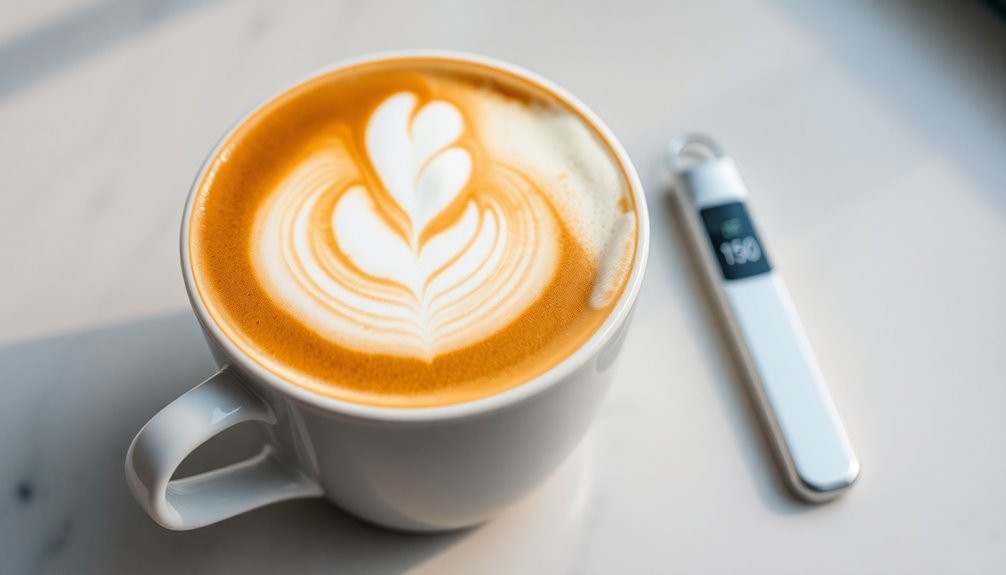
To create the perfect cappuccino, you’ll want to pay attention to the ideal temperature range, which lies between 60°C to 65°C (140°F to 149°F). When frothing the milk, aim for that velvety microfoam texture that will enhance the overall mouthfeel of the cappuccino. Another important element to consider is the ratio of espresso to milk, which should be equal parts to achieve the perfect balance of flavors. When ordering cappuccino in Italy, keep in mind that it’s traditionally enjoyed only in the morning, and asking for it with added flavors or syrups may not adhere to the traditional preparation of this beloved beverage. Additionally, remember that the quality of your espresso plays a crucial role in the overall taste of your cappuccino; using freshly ground coffee beans will make a significant difference. If you’re curious about how to order cappuccino in Italy, it’s essential to familiarize yourself with the local customs, as many Italians consider it a faux pas to have this drink after breakfast. Embracing these traditions will enhance your coffee experience while in Italy, allowing you to appreciate the craft behind this iconic beverage fully.
This prime temperature range guarantees your milk is hot enough to create a creamy texture and stable foam without scorching. Heating milk above 70°C can ruin the flavor, making it bitter and less enjoyable.
By maintaining a temperature around 65°C, you enhance sweetness perception, elevating your cappuccino experience. Consistently monitoring temperature is vital for achieving that delicate balance between hot coffee and perfectly steamed milk.
Measuring Milk Temperature Accurately
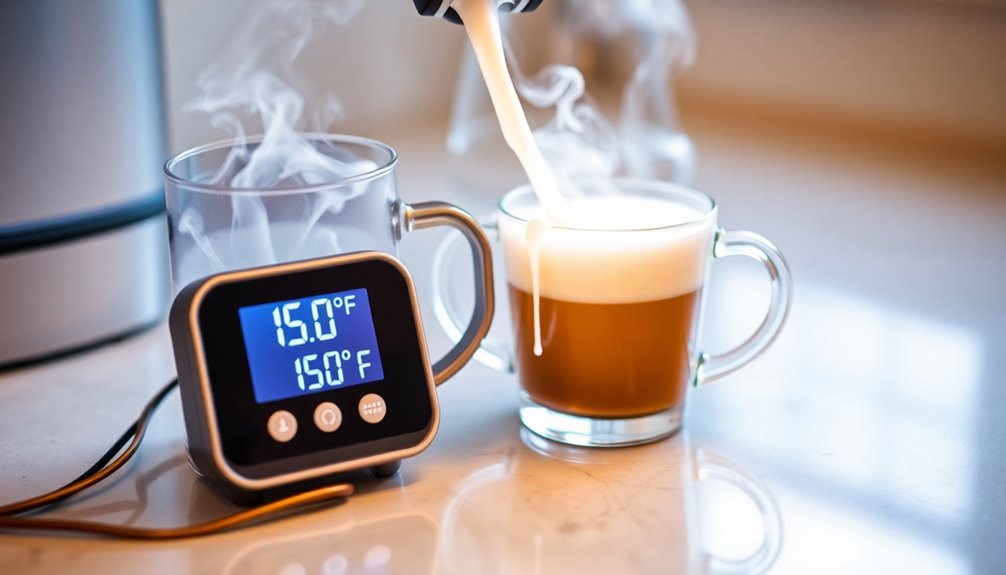
Accurate measurement of milk temperature is essential for crafting the perfect cappuccino, as it directly influences the drink's texture and flavor.
To guarantee you're hitting that ideal temperature range of 140°F to 150°F (60°C to 65°C) while frothing milk, a contactless digital thermometer is an ideal solution. This device provides quick, hygienic readings without direct contact, helping you avoid scalding and maintain the perfect foam consistency.
Regularly monitoring milk temperature during steaming won't only enhance the quality of your cappuccino but also improve your overall consistency.
Techniques for Frothing Milk
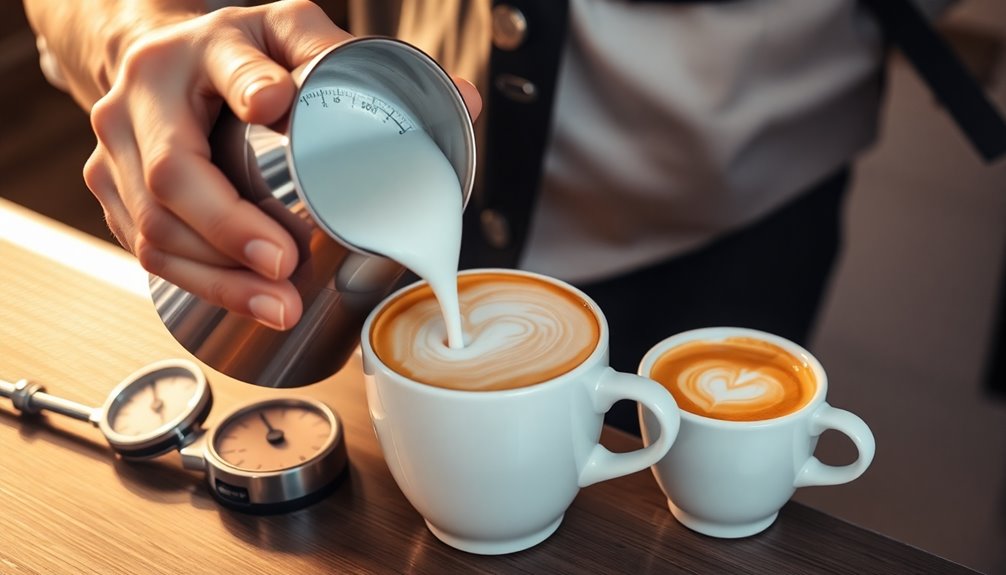
Mastering the art of frothing milk is vital for any cappuccino enthusiast.
Start by using the steam nozzle on your espresso machine, which introduces air while heating the milk, creating a velvety microfoam. Submerge the steam wand just below the surface to achieve the ideal frothing texture.
Pre-warm your frothing pitcher to enhance the heating process and guarantee consistent foam quality. Keep a thermometer handy to monitor milk temperature, aiming for the ideal frothing temperature of 150°F to 155°F (65°C to 68°C) for peak foam stability.
Proper aeration is essential; too little can lead to flat foam, while overheating results in a burnt taste and uneven texture.
With practice, you'll create perfect microfoam every time.
Common Mistakes to Avoid
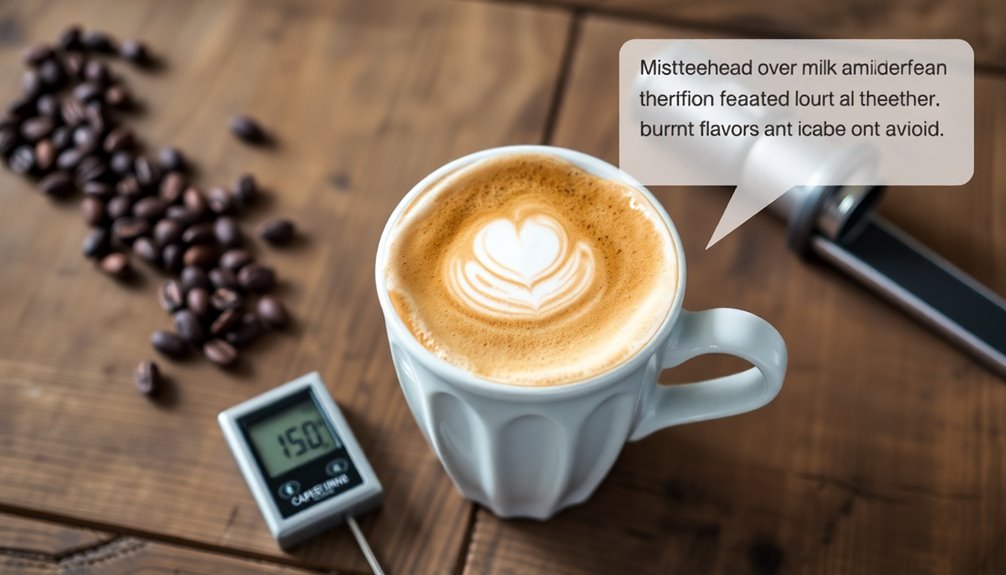
Creating great microfoam is just one part of making the perfect cappuccino; avoiding common mistakes is equally important. Here are some pitfalls to watch out for:
| Mistake | Consequence | Solution |
|---|---|---|
| Overheating milk | Scorched flavor, burnt coffee | Monitor temperature closely |
| Incorrect aeration | Poor microfoam texture | Properly aerate milk |
| Ignoring ideal range | Lack of creamy texture, sweetness | Stick to 60°C ± 5°C (140°F-155°F) |
Additionally, maintaining the right temperature is crucial for achieving a good microfoam texture, which enhances the overall flavor and presentation of your cappuccino.
Frequently Asked Questions
What Is the Final Temperature of a Perfect Cappuccino?
When you think about the final temperature of a perfect cappuccino, aim for around 60°C to 65°C.
This range enhances the drink's flavor and texture, making it more enjoyable. If you let the milk go above 70°C, you risk burnt flavors and poor froth quality.
What Is the Ideal Temperature for Frothing Milk?
You might think frothing milk is just about getting it hot, but it's actually a delicate dance of temperature!
The ideal frothing temperature ranges from 150°F to 155°F. If you go above 160°F, you'll risk ruining the flavor with a scorched taste. Keep a close eye on that thermometer; it's your best friend.
Whole milk gives you the creamy texture you crave, while skim milk offers more foam but less richness.
What Are the Standards for Cappuccino?
To make a great cappuccino, you should focus on a few key standards.
First, use equal parts espresso, steamed milk, and milk foam for balance. Aim for a rich, creamy texture by frothing your milk properly.
Pay attention to the quality of your ingredients; fresh coffee and milk make a big difference.
Finally, serve it in a pre-warmed cup to enhance the overall experience.
Following these standards will elevate your cappuccino game!
Should Cappuccino Be Boiling Hot?
No, cappuccino shouldn't be boiling hot. When you serve it at high temperatures, you risk scorching the milk, which leads to a bitter taste and an unpleasant aroma.
Plus, extreme heat can ruin the creamy froth, making it thin and unstable. Instead, aim for a temperature that highlights the drink's sweetness and flavors.
Enjoying your cappuccino at an ideal temperature enhances the overall experience, allowing you to savor every sip.
Conclusion
To savor a sensational cappuccino, remember to master the milk's magic. Keeping the temperature within the ideal range guarantees a delightful drink, bursting with balanced flavors. Measure meticulously and froth fervently to achieve that perfect foam. Avoid common blunders, and you'll craft a creamy cup that captivates your coffee cravings. So, go ahead and enjoy every heavenly sip of your expertly made cappuccino—it's a comforting, caffeinated companion that's sure to brighten your day!

